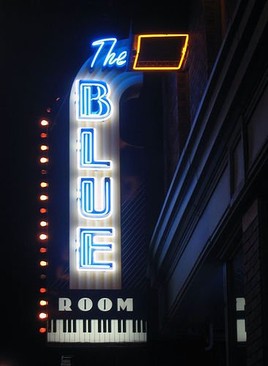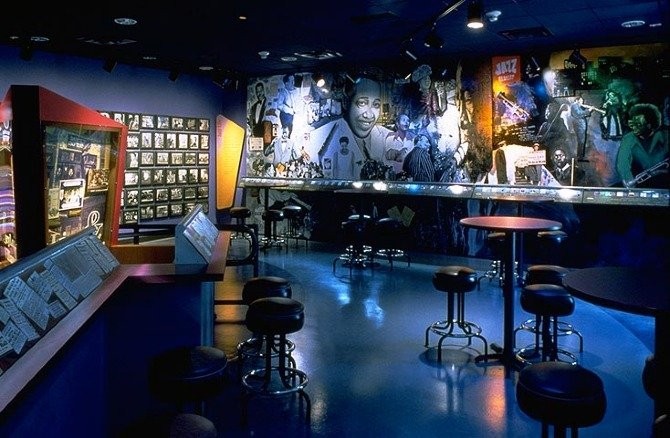The Blue Room
Introduction
Author-Uploaded Audio
Introduction to the history of the Blue Room by Michael Patton; recording created by Black Archives of Mid-America
Text-to-speech Audio
A modern landmark within the historic 18th & Vine district, The Blue Room Jazz Club is connected to the American Jazz Museum and showcases some of the most significant jazz musicians. A museum by day and hopping jazz club at night, the Blue Room blends music and entertainment with history and is a favorite for many residents of the Kansas City metro area. Established by Reuben and Ella Street as part of the Street Hotel (or "Street's," as it was known) in the early 1920s, the Blue Room became one of the most important venues in the geography of Kansas City jazz. The original Blue Room and the hotel that housed it were located just a few steps west of the current Blue Room. That historic building was razed in the 1980s and is now home to Soiree and several other businesses.
Images
The electric Blue Room sign illuminated in fabulous blue!


Backstory and Context
Text-to-speech Audio
Perhaps the most unique of all venues on 18th & Vine, the Blue Room Jazz Club connects the past to the present and offers a performance venue for established and up-and-coming musicians. The club is connected to the American Jazz Museum and honors the musical tradition of the famous Blue Room of the Street Hotel. One of the few places of accommodation for people of color in the era of segregation, the Street Hotel was a center of social life, a place where Black organizations held events and conferences, and the place where out-of-town visitors stayed, including ballplayers and musicians.
Street Hotel was owned and operated by Reuben and Ella Davidson Street. When Reuben was a child, his family moved to Kansas City as part of the migration of Exodusters—African Americans who left the south to seek a better life in Kansas and Kansas City, which straddles the Missouri-Kansas border. Reuben and Ella married in 1900 and held a variety of jobs before managing to purchase the hotel that would bear their name in 1920. In the segregated city, Street Hotel was the finest hotel available to Black patrons, and segregation meant that other African-American businesses, clubs, and venues clustered around it in the 18th & Vine district, creating a busting jazz scene even as Black performers and audiences were excluded from businesses in downtown Kansas City. Across from the Blue Room was the Rose Room, which offered an exclusive fine-dining experience to African American guests.
Of course, any hotel that served as the home away from home for traveling musicians became the center of nightlife, and this was certainly the case for the Street Hotel during the 1930s and beyond. The venue is both a performance hall and a “multifaceted exhibit highlighting the countless musicians who crafted” the now world-famous “Kansas City jazz” sound. The club continues to cultivate jazz talent, inviting performances from both veteran and up-and-coming musicians in its intimate and historic setting.
This hybrid venue—museum by day and working jazz club by night—is Kansas City's’ only Jazz club to be listed in the top 100 Jazz Clubs in the world by DownBeat Magazine. Because of this, the Blue Room is never in shortage of touring jazz musicians looking to make a name in the city of fountains. Another interesting tidbit regarding the Blue Room Jazz Club is the “soundies” which can be viewed in the video jukebox. These “soundies” include performances by “Jazz greats such as Louis Armstrong, Charlie Parker, Billie Holiday, Fats Waller, and John Coltrane.”
Similar to the gateway sign which signals both a respect for the district and a desire to bring life back to the venues and businesses which sat near-lifeless for years, the Blue Room Jazz Club invites aspiring musicians to play in the venue: “Bring your instrument and sit in at the weekly Blue Monday Jam.” The spirit of the Jazz District with the powerful and influential musicians that played in the clubs and streets of 18th & Vine lives on through these events, which invite the public in to be part of the marvelous history of jazz in Kansas City.
Sources
Blue Room Jazz Club. American Jazz Museum. Accessed November 27, 2017. https://americanjazzmuseum.org/blueroom.
The Blue Room at the American Jazz Museum. https://www.visitmo.com/the-blue-room-at-the-american-jazz-museum.aspx
Great Contemporary Jazz Coming Your Way This Week at the Blue Room!. Wordpress. https://jazzartistrynow.wordpress.com/tag/kansas-city/.
Jones, Tina Cahalan. Reuben and Ella Davidson Street and their Kansas City Blue Room, From Slaves to Soldiers and Beyond - Williamson County, Tennessee's African American History. March 8th 2019. Accessed February 12th 2020. http://usctwillcotn.blogspot.com/2019/03/reuben-and-ella-davison-street-and.html.
Image: The Blue Room Sign
Permanent Exhibitions. American Jazz Museum. https://americanjazzmuseum.org/exhibition/permanent-exhibitions. Image: Bar
